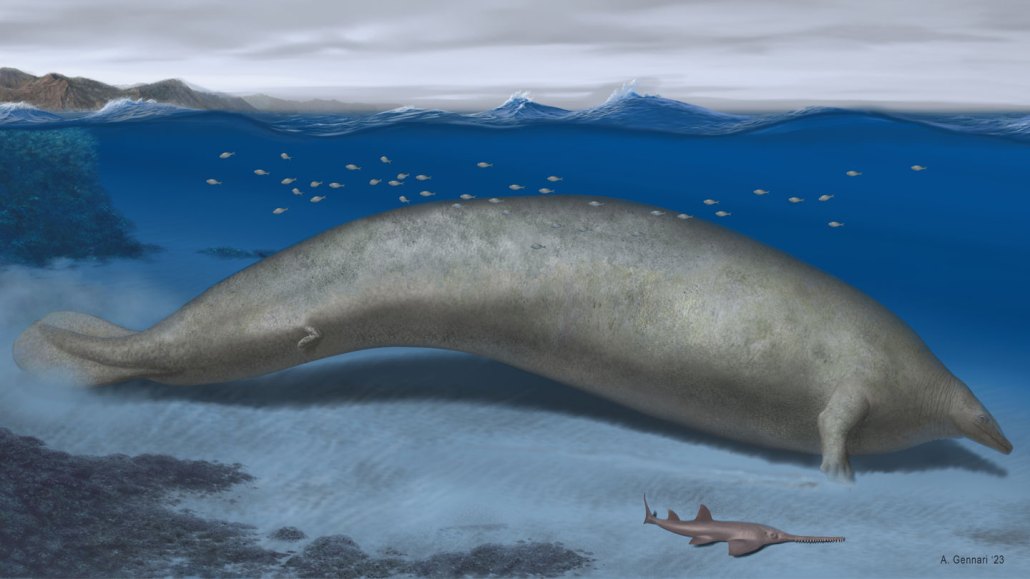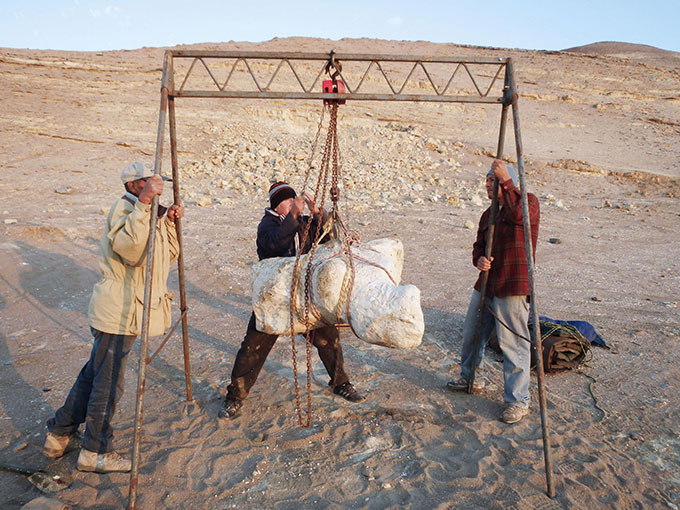This massive ancient whale may be the heaviest animal ever known
Its fossils suggest it may have tipped the scales at up to 340 metric tons

One ancient whale — Perucetus colossus (illustrated) — might have edged out blue whales for the title of heaviest known animal. Scientists estimate it could have weighed far more than a Boeing 747 airplane.
Alberto Gennari
Share this:
- Share via email (Opens in new window) Email
- Click to share on Facebook (Opens in new window) Facebook
- Click to share on X (Opens in new window) X
- Click to share on Pinterest (Opens in new window) Pinterest
- Click to share on Reddit (Opens in new window) Reddit
- Share to Google Classroom (Opens in new window) Google Classroom
- Click to print (Opens in new window) Print
By Skyler Ware
Listen to this story:
Have feedback on the audio version of this story? Let us know!
Move over, blue whales. There appears to be a new heavyweight champ.
Fossil vertebrae and ribs from an extinct whale suggest that it could have outweighed modern blue whales. If so, this ancient mammal — Perucetus colossus — would be the heaviest animal ever known to exist. A new report on this mega-whale appeared August 2 in Nature.
P. colossus is a type of cetacean. This group of water-dwelling mammals includes modern whales, dolphins and porpoises. Scientists estimate this colossal relative lived 39 million years ago. Its bones are massive. Its skeleton, the researchers estimate, alone could have weighed between 5 and 7 metric tons (roughly 11,000 to 15,500 pounds). That’s two to three times as much as the skeleton of a blue whale that was 25 meters (82 feet) long.
The fossils were found in southern Peru. They were “clearly something exceptional from the first look,” says paleontologist Eli Amson. He works at the State Museum of Natural History in Stuttgart, Germany.

Thirteen vertebrae from one of these behemoths have been unearthed. Exceeding 100 kilograms (220 pounds), each of these bones from its back weighed more than a baby elephant. “You don’t move a vertebra like this by yourself,” Amson says.
Such heavy bones suggest that the whale lived in shallow, coastal waters. For deep dives, Amson and his colleagues note, whales need a lighter skeleton. That would let them come back up for air without working too hard. But the massive bones of P. colossus could have helped it hover at shallow depths. The weight of its skeleton would have balanced the upward buoyant force from all the air in its lungs.
Overall, P. colossus could have weighed anywhere from 85 and 340 metric tons, the team estimates. That’s at least as much as a typical blue whale — but up to as much as eight passenger jets. In fact, the animal’s true mass is difficult to know for sure. Fossils provide only a rough gauge of how much its muscles, organs and other soft tissues would have weighed.
Some scientists are skeptical that P. colossus could have reached the upper end of that mass range. Without a fossil skull, it’s hard to know what P. colossus could have eaten to sustain such an enormous size, says Nicholas Pyenson. A paleontologist, he works at the Smithsonian National Museum of Natural History in Washington, D.C. Pyenson did not take part in the study.
Amson hopes to find a more complete specimen of the ancient whale. That would help his team better understand how this colossus sustained its heavyweight status.







